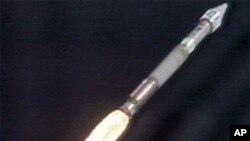The sun is the driving force behind the Earth's climate, but changes in the sun affect more than just the weather on this planet. NASA has launched its Solar Dynamics Observatory, which is expected to deliver unparalleled images of the sun. These images will allow scientists to study "space weather" that can affect satellite communications, navigation systems and even electrical power lines here on Earth.
NASA launched its new Solar Dynamics Observatory Thursday on an unmanned Atlas V rocket from the southeastern U.S. state of Florida.
Launch commentator audio:
"4, go for main engine start 3-2-1-0-and ignition and liftoff of the Atlas V with the Solar Dynamics Obervatory, learning why our star is changing our lives."
That star is the sun, the closest star to our planet. We experience the sun's warmth and light firsthand, but we also experience the effects of the sun's changing magnetic field here on Earth, perhaps without even realizing it.
Scientist Dean Pesnell says changes in the sun's magnetic field cause what scientists call "large particle events" - and such an event was even behind a blackout in southern Sweden seven years ago.
"When the sun has a large particle event, those particles come through, interact with our magnetic field and can actually take down a power system," said Dean Pesnell. "The most recent example was the town of Malmo in Sweden, which lost its power in 2003."
Pesnell works at NASA's Goddard Spaceflight Center just outside Washington. He explains that the sun is dynamic. Its changing magnetic field sends electrically charged particles into the solar system, or it converts to explosions in the sun's atmosphere or eruptions that release billions of tons of solar material into space.
Such activities alter the levels of energy and radiation in our solar system and can affect technology, such as satellite communications and navigation systems.
But Pesnell explains we do not always feel the direct impact here on Earth.
"It is kind of like standing there with a water hose spraying and then you spin around on a turntable," he said. "f your friend is standing somewhere, you only hit them every once in a while when the water hose happens to pass by them."
The sun is the source of space weather, such as solar wind, solar flares and eruptions. It is the sun's effect on space weather, and space weather's effect on us, that has NASA scientists excited about the new Solar Dynamics Observatory. The mission will determine how the sun's magnetic field is generated and destroyed and give scientists insight into space weather.
Pesnell is a Solar Dynamics Observatory project scientist. The observatory is expected to reveal the sun's inner workings by
constantly taking high-resolution images of the sun, collecting readings from inside the sun and measuring its magnetic field activity.
The observatory will provide images unlike anything that have been recorded so far, providing details of the sun and its features.
"We estimate it will be one image every three-quarters of a second," he said.
This data is expected to help researchers eventually predict solar storms and other solar activities that can affect spacecraft in orbit, as well as power, communications and navigation systems here on Earth.
NASA says the observatory's images will have 10-times better resolution than high-definition television.
"We hope that it will be displayable as a near real-time movie," said Dean Pesnell. "The data should be available fairly soon after it comes down for making movies that people can look at to find interesting events."
The observatory's prime mission is expected to last five years, with the observatory sending down about 1.5 terabytes of data daily. To compare, NASA says that is about the equivalent of downloading half-a-million songs each day.
NASA had planned to send the observatory into space Wednesday, February 10, but the U.S. space agency had to postpone the launch by one day because of gusty winds. It seems even the study of space weather can be set back by weather here on Earth.
NASA Launches Observatory to Study Sun and Space Weather








